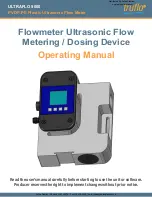
7
Troubleshooting
Baseline Noise at Low Pressures
88
Accela Pump Hardware Manual
Thermo Scientific
If the problem still persists after replacing the seals, the problem is likely due to a
contaminated check valve. For low flow (< 50
μ
L/min) applications, cleaning a check valve is
normally not effective. Most likely you must replace one or both check valve assemblies.
Pressure Pulsations with SD between 3 and 10 Bar
Pressure pulsations with a standard deviation of 3 to 10 bar are of various origins. You can
continue working, but you should try to find the reason for the pulsation as soon as possible.
Baseline Noise at Low Pressures
UHPLC pumps are optimized to deliver a constant flow with a minimum of pressure
fluctuations when they are set up to operate at an appropriate backpressure. The Accela Pump
provides stable flow in both operating modes: low pressure and high pressure. When your LC
system is set up to operate at a backpressure below 7000 psi (483 bar), make sure that you
select the low-pressure operating mode (0 to ~7000 psi) for your instrument control method.
Under extreme conditions (flow rates of less than 100
μ
L/min) and with a low backpressure
(less than 40 bar), you might observe a slight instability in the detector baseline at high
sensitivity.
This problem can usually be fixed by adding a flow restrictor to your system between the
Accela Pump and autosampler to increase the backpressure to a level greater than 40 bar
(4 MPa, 580 psi).
Some typical applications susceptible to this problem include the following:
• Flow Injection Analysis (FIA) using an LC/MS performed at 10 to 50
μ
L/min without an
HPLC column
• Capillary LC at 3 to 5
μ
L/min and 15 to 20 bar
Any variation of backpressure and flow rate will affect the UV detector performance at high
sensitivity. The Accela Pump should normally be operated with at least 40 bar of
backpressure. If necessary, use a flow restrictor to increase the backpressure of your system.
















































